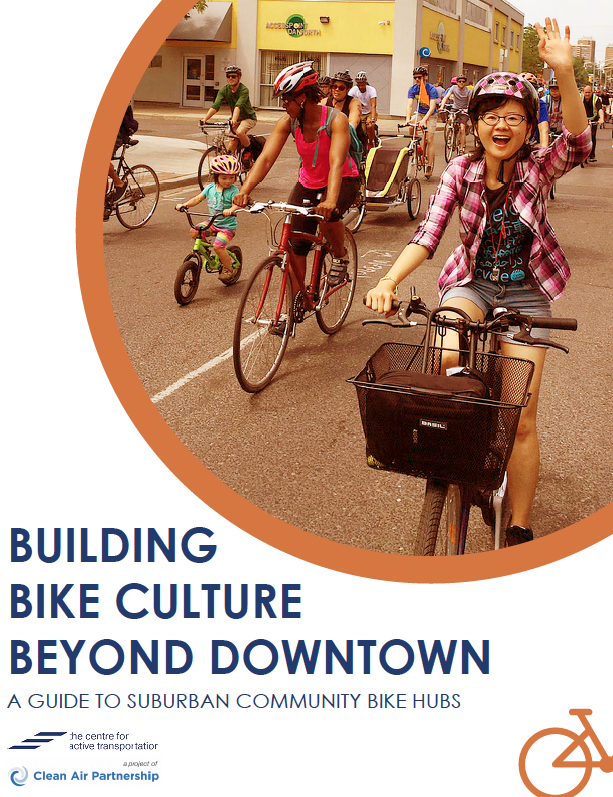Building Bike Culture Beyond Downtown: A guide to suburban community bike hubs is a new report by The Centre for Active Transportation at Clean Air Partnership, produced with funding from the Metcalf Foundation and Mitacs. The report is both an analysis of impediments to cycling that suburban Toronto communities face and a how-to manual on ways to encourage cycling outside Toronto’s downtown core.
The report’s authors begin by defining a community bike hub. It is both a physical and psychological space, a place where people can come together to learn more about cycling, how to fix their bikes, meet other people who cycle, and go cycling together. Such hubs are key to supporting cycling growth in neighbourhoods that currently lack safe cycling infrastructure, and have limited if any bike shops, and lack a robust existing cycling culture.
Cycling in downtown Toronto has been a success story, with the number of cyclists steadily increasing over the last 25 years. However, the reverse is true in the city’s inner suburbs: in places like Etobicoke, North York, and Scarborough, fewer people now cycle either for recreation or to commute than in 1996.
Given this state of affairs, the authors ask themselves how a cycling culture could be built in suburban areas like Etobicoke, Scarborough, and North York where 1. 5 million trips are made daily that are 5 km or less, most of which are not by bike. In spite of the obvious health and economic benefits, residents in suburban communities are hesitant to travel by bike due to a lack of proper infrastructure, such as separated bike lanes. And without a critical mass of cyclists, politicians are reticent to install protected bike lanes, which would encourage people to cycle.
To overcome this “frustrating chicken-and-egg scenario”, the authors, while acknowledging the critical need for infrastructure, focus on promoting behavioural change. The Centre for Active Transportation (TCAT) honed this approach over the last three years through the creation of two community bike hubs in Scarborough. When they began in 2015, Scarborough had only “one bike shop, next to no bike lanes, and very few cyclists”. By 2018, the staff and volunteers at the newly created bike hubs had led over one thousand people on rides, repaired two thousand bicycles, and held 12 cycling skills workshops. Building Bike Culture Beyond Downtown draws extensively on this experience.
TCAT has developed a comprehensive four-step model for “incubating” a bike hub, which includes finding the neighbourhood, identifying local barriers, setting up the hub, and ensuring that people keep cycling through various initiatives such as bike maintenance workshops and special event rides. Cycling organizations are encouraged to team up with local agencies that work in health, youth, poverty reduction, settlement services, or employment skills and which already have some cycling and programming expertise. Once up and running, these local agencies would ultimately take complete responsibility for running the bike hub, leaving cycling organizations free to concentrate their efforts elsewhere. The strength of this approach lies in anchoring the bicycle hubs in local agencies who already have physical space, staff, and perhaps most importantly, local recognition, and credibility.
Building Bike Culture Beyond Downtown: A guide to suburban community bike hubs and the model it describes can be applied to cities elsewhere. Though promoting suburban cycling in a car-centric culture can seem daunting, the authors conclude that there is an “appetite for change.” Building Bike Culture Beyond Downtown underscores the vital role that effective, non-governmental community organizing can play in making our citizens healthier and our cities greener by getting more people out and riding.


